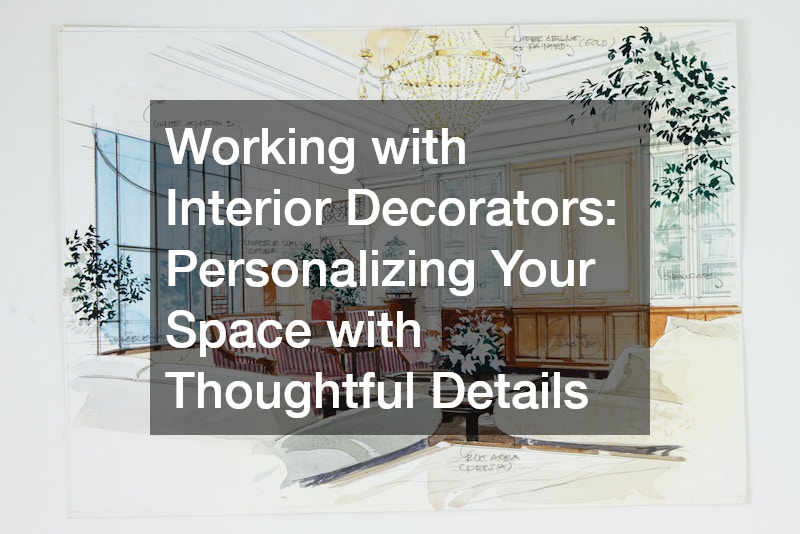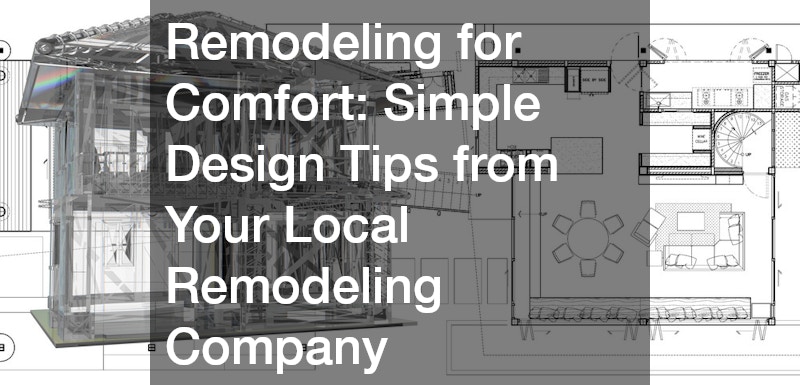Interior design is more than just aesthetics; it is about crafting spaces that reflect one’s personality and provide comfort and functionality. An eye for detail can transform an ordinary room into an extraordinary one, showcasing the occupant’s style and taste. By incorporating various elements such as color, texture, and lighting, one can create a harmonious atmosphere that caters to both practical and aesthetic needs.
Strategic interior design details play a vital role in enhancing the overall ambiance of a home. Whether you’re engaging with a painting company or an interior decorator, these professionals can help you make informed decisions. This article will explore key themes and collaborations within interior design, providing insights into creating spaces that are both beautiful and functional.
Embarking on a home improvement journey involves collaboration with various experts, from kitchen renovators to residential electricians. Each professional brings expertise and vision, contributing to the seamless integration of different design elements. This article will delve into how these collaborations can accentuate interior design details, creating a cohesive environment that exemplifies personal style.
The Impact of Color: Choosing Paint with a Professional Painting Company

Color is a fundamental component of interior design, capable of altering perceptions and affecting emotions. Collaborating with a professional painting company can ease the selection process, ensuring the right shades amplify your home’s ambiance. By exploring different palettes, homeowners can identify colors that resonate with their personal style and complement existing interior design details.
Professional painters can provide valuable insights into trending colors and timeless classics, guiding clients toward choices that reflect contemporary tastes while honoring individuality. They can also advise on the best finishes and techniques to enhance color saturation and longevity. With their expertise, a painting company helps translate a homeowner’s vision into reality, aligning aesthetic desires with practical needs.
Color can also influence room perception; lighter colors may make a space feel bigger, while darker hues can create an intimate atmosphere. When coordinated with other interior design details, these choices can transform spatial dynamics and highlight architectural features. The right color palette, chosen in collaboration with a painting company, can redefine the spaces we inhabit.
Working with Interior Decorators: Personalizing Your Space with Thoughtful Details

Interior decorators have the skills to personalize spaces with thoughtful details, creating harmony and balance within a home. These professionals understand how to blend various elements, such as furniture, artwork, and decorative accessories, to reflect an individual’s taste and lifestyle. By emphasizing key interior design details, decorators can breathe new life into any room.
Working alongside clients, interior decorators curate selections that align with personal preferences while maintaining aesthetic coherency throughout the home. From selecting curated artwork to arranging bespoke furniture pieces, decorators focus on the cohesive integration of design elements. Their expertise bridges the gap between function and beauty, making every space both usable and visually appealing.
Besides aesthetics, interior decorators also consider practical concerns like space optimization and storage solutions. They provide creative strategies that balance functionality with decor, ensuring every square inch serves a purpose. Through this thoughtful approach, decorators help enhance the comfort and usability of spaces, enriching interior design details with personalized flair.
Remodeling for Comfort: Simple Design Tips from Your Local Remodeling Company

Engaging a local remodeling company offers innovative insights into transforming spaces for enhanced comfort. With an emphasis on simple design tips, these experts demonstrate how minor alterations can significantly impact living areas. Remodeling teams consider interior design details carefully, ensuring any update aligns with broader aesthetic goals.
Key to this process is understanding the homeowner’s vision and how it pertains to everyday living. Remodeling companies focus on making practical yet stylish improvements, such as installing built-in storage or updating countertops. Small adjustments like these can dramatically improve a home’s functionality without losing sight of its design ethos.
Furthermore, remodeling professionals often propose eco-friendly solutions to enhance sustainability. Whether it’s through energy-efficient lighting or using recycled materials, these initiatives can reduce environmental impact while enriching the space. An adept remodeling company visualizes both immediate upgrades and long-term benefits, synthesizing design ideas into a coherent concept for enhanced livability.
Creating a Cozy Kitchen: Insights from Kitchen Renovators on Ambiance

Kitchen renovators are instrumental in designing spaces that are as inviting as they are functional. The kitchen is often the heart of the home, a place where ambiance matters significantly. Kitchen renovators focus on integrating interior design details that foster warmth and sociability.
The right balance of cabinetry, lighting, and color can transform a kitchen into a convivial space. Renovators work with various elements, like selecting the perfect countertops or backsplash that maximize visual and practical appeal. Every choice made aims to enhance usability while maintaining a welcoming atmosphere.
Beyond aesthetics, kitchen renovators emphasize efficient layouts that support everyday cooking and gathering. They propose solutions to streamline movement and access, offering smart storage options that reduce clutter. By selecting harmonious materials and fixtures, they ensure that each kitchen is a cozy and functional retreat within the home.
Whole House Remodeling: Harmonizing Design Details Across Your Home
Whole house remodeling involves a synchronized approach to upgrading a home’s interior design details. When every aspect of a home is interconnected, changes must be harmonized to create a seamless visual flow. This type of remodeling embraces a comprehensive perspective, addressing design challenges holistically.
From the kitchen to the bedroom, each space should exhibit continuity in style and materials. A unified color scheme or recurring design patterns can tie the entire home together, with every detail intentionally chosen for cohesion. Whole house remodeling requires collaboration among different specialists, from designers to contractors, to ensure a consistent aesthetic.
When executed well, whole house remodeling not only boosts visual appeal but also enhances the home’s functionality and value. Whether integrating smart home technology or updating foundational elements like plumbing, this integrative approach promises durable and stylish results. By considering each room’s unique needs while weaving in larger design elements, this process results in a beautifully harmonized home.
Lighting Matters: Collaborating with Residential Electricians for the Perfect Glow
Lighting is crucial to enhancing interior design details, with its ability to alter mood and perception within a space. Residential electricians bring expertise to this element, helping homeowners achieve the perfect balance of natural and artificial lighting. Their knowledge enables them to recommend innovative solutions that illuminate and accentuate each room effectively.
Electrical professionals can guide clients in selecting appropriate fixtures that blend seamlessly with existing decor. Whether it’s ambient lighting in a living room or task lighting above kitchen counters, electricians ensure each space receives light tailored to its use. Collaborating with residential electricians can uncover new possibilities in lighting design, enhancing both functionality and aesthetics.
Additionally, incorporating energy-efficient lighting solutions can contribute to sustainable living while reducing electricity bills. Residential electricians may suggest LED installations or smart lighting systems that adapt to daily routines, enhancing convenience. Through such collaboration, homeowners can enjoy beautifully lit environments that highlight interior design details with both style and responsibility.
Textural Elements: Incorporating Hardwood Floors for Warmth and Style
Hardwood floors are prized for their natural beauty and the warmth they add to any space. Their timeless appeal makes them a favorite among designers looking to strengthen interior design details. With various wood types, finishes, and patterns available, hardwood flooring offers diverse options for personalizing a home.
The installation of hardwood floors can redefine a room’s aesthetic by introducing a natural, textural element that complements other design features. These floors are versatile, pairing well with both modern and traditional decors. Hardwood can lend character to open-plan layouts and create cozy atmospheres in smaller rooms.
Apart from aesthetics, hardwood floors are valued for their durability and easy maintenance. They withstand heavy foot traffic, making them an ideal choice for family homes. When selected and installed thoughtfully, hardwood floors enhance a room’s design narrative, showcasing sophistication and comfort in equal measure.
Enhancing Curb Appeal: How Residential Roofing Can Complement Your Interior
A home’s exterior is the first impression it makes, and residential roofing plays a key role in its appearance. The choice of roofing materials and design can significantly impact curb appeal, often reflecting and complementing interior design details. The right roofing solution not only protects a home but also enhances its visual harmony from the outside in.
Consider how roofing color, texture, and style align with the home’s overall architectural theme. For instance, a modern metal roof can match minimalist interior design, while classic shingles might complement a traditional home. Consulting with roofing experts ensures that the chosen materials and styles support both exterior and interior aesthetics.
Beyond appearance, functional benefits also guide roofing decisions. Energy-efficient roofing can reduce environmental impact and maintain home comfort by regulating temperatures. By integrating thoughtful roofing choices, homeowners can achieve a seamless transition between exterior curb appeal and interior design elegance, showcasing comprehensive design coherence.
Smart Upgrades: Integrating Electrical Panel Upgrades into Your Design Plan
Updating your electrical panel is not only about safety and functionality but also about aligning with modern interior design trends. An electrical panel upgrade ensures that homes can support advanced technologies and contemporary appliances that demand higher electricity loads. Such upgrades are foundational to integrating smart home solutions, enhancing convenience and efficiency in daily life.
Residential electricians can strategically plan electrical panel upgrades to blend seamlessly with interior design details, minimizing disruptions. Through careful planning, they optimize layout and access, ensuring that modern aesthetic needs are met without compromising functionality. An up-to-date electrical system lends itself to advanced lighting solutions and smart devices, supporting a modern lifestyle.
The benefits of electrical panel upgrades extend beyond aesthetics and functionality; they also offer peace of mind through improved safety standards. Ensuring that electrical infrastructure adheres to current codes can prevent potential hazards and facilitate property value increases. By incorporating an electrical panel upgrade into your design plan, you sustain a balance of beauty and practicality.
Building a Welcoming Atmosphere: Tips from Home Builders on Design Details
Home builders play an essential role in establishing the foundational elements of design that create a welcoming atmosphere. They focus on interior design details that contribute to a harmonious and inviting home environment. By partnering with homeowners early in the planning stages, builders can influence essential decisions that set the tone for the entire residence.
Constructing with an emphasis on open-plan spaces and natural light can foster a sense of warmth and openness. Home builders may also incorporate eco-friendly materials and energy-efficient systems, aligning contemporary aesthetic goals with sustainability. By integrating thoughtful design choices from the start, these professionals help ensure a home’s ambiance exudes comfort and style.
Involving home builders in the broader design process allows for creative input that enhances both form and function. Their experience with space optimization and structural considerations can guide projects towards achieving specified design outcomes. Through collaboration, builders transform ideas into reality, producing spaces that reflect both personal style and innovative design principles.
The Art of Layering: Simple Decorative Touches to Elevate Any Room
The art of layering involves skillfully combining different design elements to add depth and interest to a room. Layered interiors can infuse spaces with richness, showcasing a diversity of textures, patterns, and colors. By focusing on such interior design details, homeowners can create rooms that are engaging and dynamic.
Simple decorative touches like adding throw blankets, cushions, or area rugs can make a significant impact. These elements offer an opportunity to introduce new textures and colors, changing the room’s mood and highlight design focal points. Mixing and matching accessories can also reflect shifts in seasonal trends or personal taste, providing flexibility in design.
Layering is about creating a harmonious balance without overwhelming the senses. By carefully selecting which elements to feature and how to combine them, design can reach new heights. The effective art of layering involves intuition and creativity, offering endless possibilities for elevating interior spaces.
Using Natural Elements: Bringing the Outdoors In for a Serene Ambiance
Integrating natural elements into interior spaces can cultivate a serene and refreshing ambiance. Nature-inspired interior design details like wooden finishes, stone accents, and natural textiles bring the calmness of the outdoors into homes. By using such materials, decorators can forge a strong connection between a home’s interior and the surrounding environment.
Houseplants are a popular choice for adding a touch of nature indoors. They enhance air quality and contribute organic shapes and colors, harmonizing with a variety of decor styles. Whether through a collection of small succulents or a striking statement palm, plants provide vitality and softness to any room.
Apart from plant life, integrating nature-focused elements such as natural light and earthy colors can influence the atmosphere. By strategically placing mirrors or choosing light-reflecting surfaces, homes can maximize natural light’s positive effects. With natural elements thoughtfully included, homeowners enjoy spaces that nourish the mind and soothe the soul.
Designing Functional Spaces: Balancing Aesthetics with Everyday Use
Designing functional spaces means striking a balance between beauty and practicality, focusing on interior design details ensuring usability and style. It involves planning layouts that support daily activities while prioritizing visual appeal. Successful design considers aspects like traffic flow, furniture placement, and storage needs, creating a coherent and efficient environment.
Functional design isn’t limited to utilitarian considerations—it also enhances joy and inspiration within spaces. By incorporating flexible furniture or convertible spaces, homes can easily adapt to different uses and activities. Emphasizing comfort and accessibility, designers can create spaces that facilitate both relaxation and productivity.
Regular consultation with skilled designers helps achieve this balance, providing expertise on maximizing a room’s potential. Such collaboration ensures each element within a space serves a purpose, contributing to an overall sense of cohesiveness and order. By blending functional design with aesthetic principles, homeowners create environments that are both beautiful and livable.
Interior design is a multifaceted discipline that requires attention to detail and collaboration with various professionals. Through strategic use of color, lighting, texture, and other elements, homeowners can create spaces that reflect their personality and meet their practical needs. By engaging with experts like a painting company, interior decorators, and home builders, one ensures that these elements are skillfully integrated into a cohesive design strategy.
Successful interior design balances aesthetics and practicality, enhancing spaces whether through whole house remodeling or simple decorative touches. The thoughtful inclusion of various design components like hardwood floors or residential roofing can transform how a home feels and functions. Through understanding and application of interior design details, creating a beautiful and functional home becomes a rewarding endeavor.
This article has explored various perspectives on interior design, emphasizing collaboration and the importance of detailed planning. Whether embarking on a remodeling journey or updating a single room, informed decisions guided by expert insights create harmonious and enjoyable environments. With careful consideration, every home can achieve elegance and efficiency, offering a sanctuary tailored to its inhabitants’ needs and desires.
